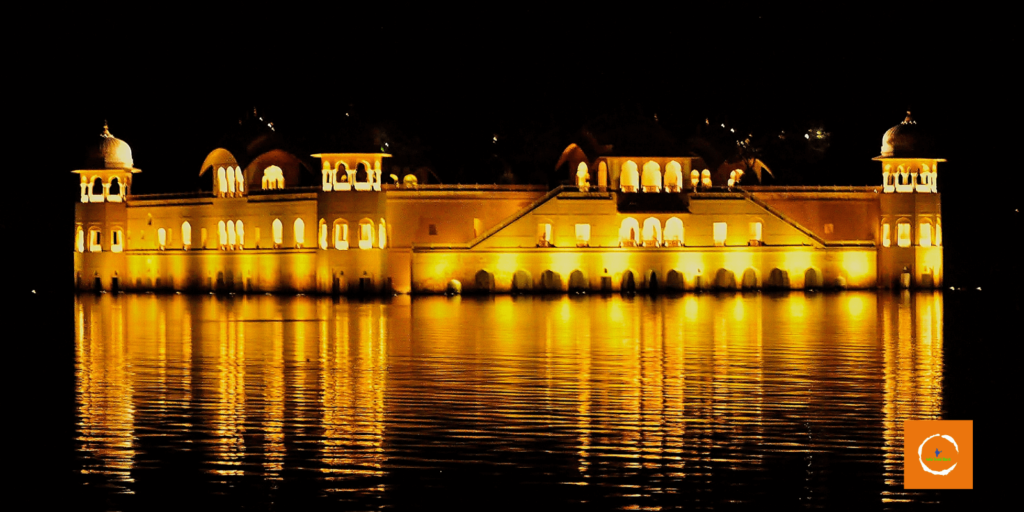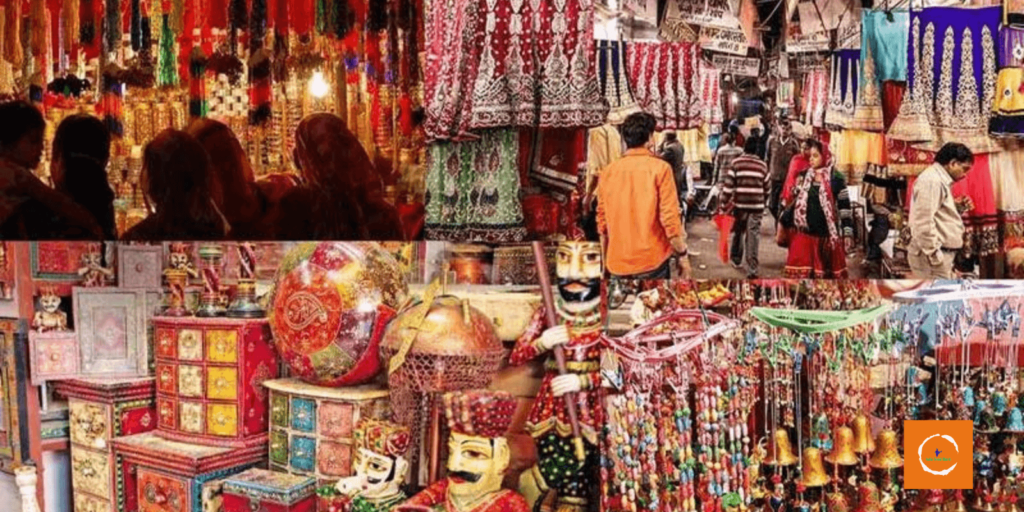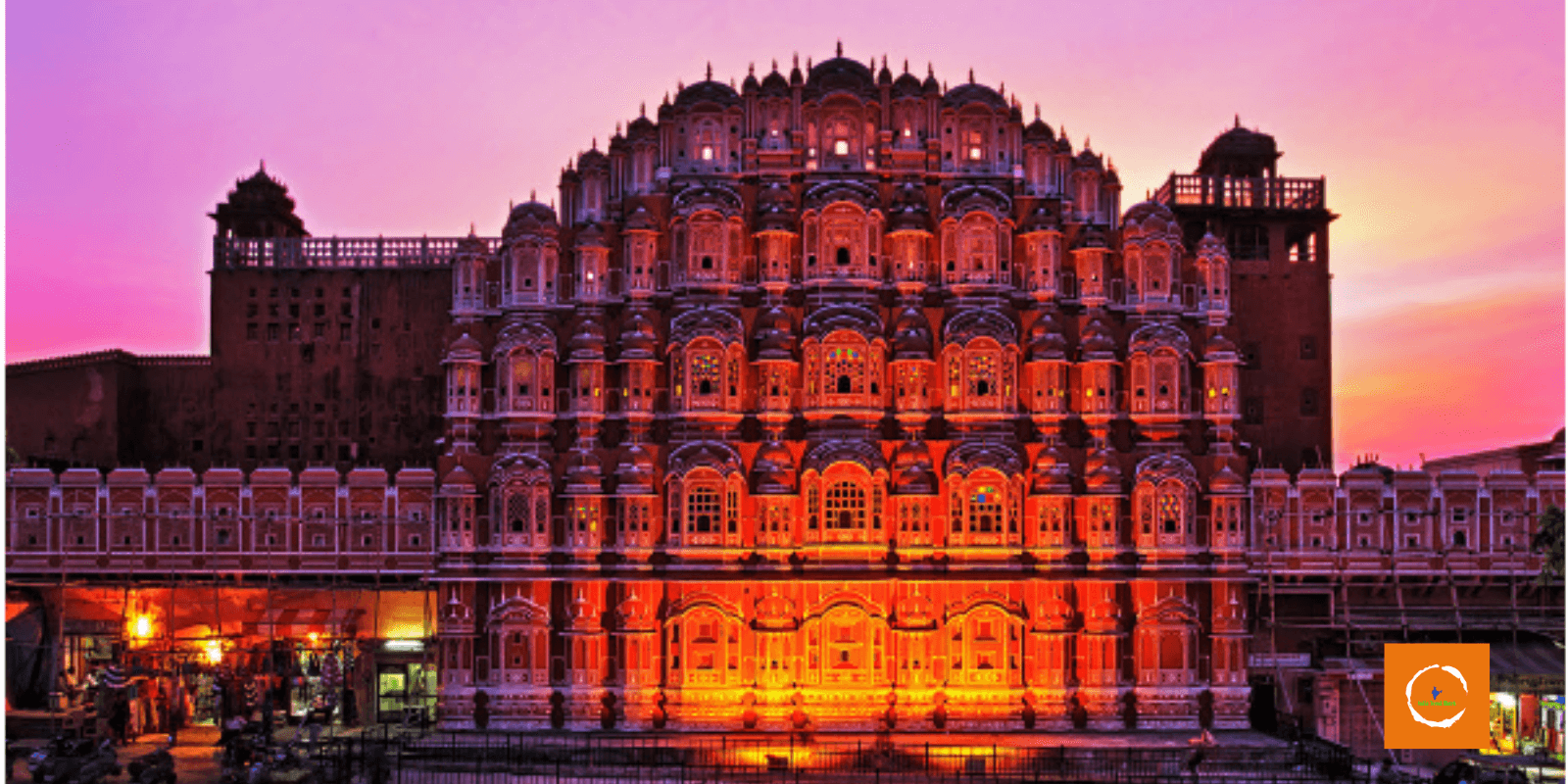Introduction
Nestled in the heart of Rajasthan, Jaipur stands tall as a beacon of India’s rich history and vibrant culture. Fondly known as the Pink City due to its terracotta-hued buildings, Jaipur is a treasure trove of majestic palaces, ancient forts, and bustling bazaars. Places to Visit in Jaipur in 2 Days is a vast list.
Stepping into Jaipur feels like stepping back in time, as every corner of the city whispers tales of its royal past. From the opulent City Palace to the intricate Hawa Mahal, each architectural wonder tells a story of grandeur and legacy. The city’s forts, including Amber Fort and Nahargarh Fort, stand as formidable guardians of bygone eras, offering panoramic views of the surrounding landscapes.
But Jaipur isn’t just about history; it’s a melting pot of cultures, traditions, and flavours. The aroma of spicy street food fills the air, tempting taste buds with savoury delights like pyaaz kachori and ghevar. From traditional Rajasthani thalis to sumptuous Mughlai feasts, Jaipur’s culinary scene is a gastronomic adventure waiting to be savoured.
As travellers embark on a journey through Jaipur’s labyrinthine streets, they’ll discover the city’s soul in its bustling markets, vibrant festivals, and warm hospitality. With each step, excitement mounts, promising an unforgettable exploration of Jaipur’s vibrant heritage, majestic architecture, and delectable cuisine. Get ready to immerse yourself in the magic of the Pink City, where every moment is a celebration of India’s timeless allure.
Day 1: Immersing in Jaipur’s Royal History

Morning
As the sun rises over the horizon, signalling the start of a new day in Jaipur, travellers eagerly embark on their journey through the city’s royal history. The first stop on this enchanting adventure is the iconic Hawa Mahal, also known as the Palace of Winds. This mesmerizing structure, with its intricate latticework and honeycomb windows, stands as a testament to Jaipur’s architectural splendour. Built-in 1799 by Maharaja Sawai Pratap Singh, the Hawa Mahal was designed to allow royal ladies to observe street festivals and processions while remaining veiled from public view.
Entering the Hawa Mahal feels like stepping into a fairy tale, with its whimsical facade adorned with delicate carvings and vibrant colours. As sunlight filters through the intricately patterned windows, creating a play of light and shadow, visitors can’t help but marvel at the beauty of this architectural masterpiece.
From the Hawa Mahal, travellers proceed to explore another jewel in Jaipur’s crown: the City Palace. Situated in the heart of the Old City, this sprawling complex is a perfect blend of Rajput and Mughal architectural styles. Built by Maharaja Sawai Jai Singh II, the founder of Jaipur, the City Palace served as the seat of the royal family for centuries.
Stepping into the City Palace is like stepping back in time, as visitors are transported to an era of grandeur and opulence. The palace complex houses several exquisite structures, including the Mubarak Mahal, Diwan-i-Khas, and Diwan-i-Aam, each adorned with ornate decorations and precious artefacts.
One of the highlights of the City Palace is its museum, which showcases a remarkable collection of royal artefacts, including weapons, paintings, and textiles. Visitors can admire intricately embroidered garments worn by the erstwhile rulers of Jaipur, as well as rare manuscripts and ancient manuscripts.
After exploring the grandeur of the City Palace, travellers can enjoy a stroll through the nearby Jantar Mantar, an astronomical observatory built by Maharaja Sawai Jai Singh II in the early 18th century. This UNESCO World Heritage Site is home to a fascinating collection of astronomical instruments, each designed to measure time, track celestial bodies, and predict eclipses.
As visitors wander through the labyrinthine pathways of the Jantar Mantar, they can marvel at the ingenuity of ancient astronomers and engineers who crafted these remarkable instruments without the aid of modern technology. From the massive sundial known as the Samrat Yantra to the intricately carved structures of the Ram Yantra and Jai Prakash Yantra, each instrument is a testament to India’s rich scientific heritage.
As the morning comes to a close, travellers bid farewell to the Hawa Mahal, City Palace, and Jantar Mantar, their hearts filled with wonder and admiration for Jaipur’s royal history. With memories of these architectural marvels etched in their minds, they eagerly anticipate the adventures that await them in the afternoon and evening.
Afternoon
After a captivating morning exploring Jaipur’s architectural wonders, it’s time to refuel with a hearty Rajasthani lunch at a local eatery. Rajasthani cuisine is known for its bold flavours and rich textures, and no visit to Jaipur is complete without savouring its traditional delicacies. Travellers can feast on a mouthwatering spread that includes signature dishes like Dal Bati Churma and Laal Maas.
Dal Bati Churma is a quintessential Rajasthani dish that consists of baked wheat bread (bati) served with lentil curry (dal) and a sweetened crumbled wheat dessert (churma). The combination of savoury and sweet flavours creates a delightful culinary experience that is sure to tantalize the taste buds.
For those craving a bit of spice, Laal Maas is the perfect choice. This fiery red meat curry is made with tender pieces of mutton or lamb simmered in a rich gravy of yoghurt, garlic, and traditional Rajasthani spices. Paired with piping hot rice or buttery naan, Laal Maas is a true gastronomic indulgence.
With appetites satisfied and spirits high, travellers set out to continue their exploration of Jaipur’s royal heritage. Their next destination: is the historic Amber Fort. Perched atop a hill overlooking the city, this majestic fortress is a testament to Jaipur’s glorious past and architectural prowess.
As visitors approach the Amber Fort, they are greeted by imposing ramparts and towering gates adorned with intricate carvings and ornate frescoes. Stepping through the fort’s massive gateways, travellers are transported to a bygone era of Rajput grandeur and Mughal influence.
Inside the Amber Fort, a world of wonders awaits. The palace complex boasts a myriad of opulent halls, courtyards, and gardens, each adorned with exquisite marble and sandstone decorations. Travellers can explore the Sheesh Mahal (Hall of Mirrors), where walls and ceilings are adorned with thousands of tiny mirrors, reflecting light in a mesmerizing display.
One of the highlights of a visit to the Amber Fort is the opportunity to ascend the fortress in style. Travelers can choose between an exhilarating elephant ride or a thrilling Jeep safari to reach the fort’s summit. Riding atop majestic elephants or navigating rugged terrain in a Jeep, travellers are treated to breathtaking views of the surrounding landscape as they ascend the hill.
As they reach the top of the fort, travellers are rewarded with panoramic vistas of Jaipur’s sprawling cityscape and the rugged Aravalli hills beyond. From this vantage point, they can marvel at the fort’s intricate architecture, with its soaring towers, expansive courtyards, and labyrinthine passages.
With memories of the majestic Amber Fort etched in their minds, travellers bid farewell to this architectural marvel, their hearts filled with awe and admiration for Jaipur’s rich heritage. As the afternoon draws to a close, they look forward to the evening’s adventures, knowing that the wonders of the Pink City are far from over.

Related Reads: Exploring the Magnificence of Amber Fort in Jaipur
Evening
As the sun begins its descent, casting a warm glow over the city of Jaipur, travellers embark on the next leg of their journey through the Pink City’s enchanting landscape. The evening promises a tapestry of experiences, from breathtaking vistas to bustling bazaars and savoury culinary delights.
The first stop on this evening adventure is the Nahargarh Fort, perched atop the Aravalli hills. As travellers ascend the winding roads that lead to the fort, anticipation builds for the spectacular sunset that awaits them. Nahargarh Fort is renowned for offering panoramic views of Jaipur, with its sprawling cityscape and majestic palaces bathed in the golden hues of twilight.
Arriving at Nahargarh Fort, travellers find themselves awe-struck by the beauty of their surroundings. From the fort’s lofty vantage point, they witness the sun’s fiery descent into the horizon, painting the sky with a kaleidoscope of colours. As day transitions into night, the twinkling lights of Jaipur’s bustling streets below cast a magical spell over the city, creating a scene straight out of a fairy tale.
After soaking in the mesmerizing sunset views, travellers descend from Nahargarh Fort and make their way to the heart of Jaipur’s bustling markets. Here, amidst the labyrinthine lanes of Johari Bazaar or Bapu Bazaar, they embark on a journey of discovery, exploring a treasure trove of authentic shopping experiences.
Johari Bazaar, renowned for its exquisite jewellery and gemstones, beckons travellers with its glittering displays of precious metals and sparkling gemstones. From traditional Kundan and Meenakari jewellery to modern designs inspired by Rajasthani craftsmanship, there’s something to suit every taste and budget.
Meanwhile, Bapu Bazaar offers a kaleidoscope of colours and textures, with its vibrant array of textiles, handicrafts, and souvenirs. Travellers can browse through rows of intricately embroidered fabrics, colourful puppets, and handcrafted leather goods, each offering a glimpse into Rajasthan’s rich artistic heritage.
As the evening progresses, travellers find themselves drawn to the aroma of savoury spices and tantalizing aromas wafting from the city’s rooftop restaurants. Here, amidst the romantic ambience of flickering candles and starlit skies, they indulge in a traditional Rajasthani dinner.
Savouring delicacies like Dal Bati Churma, Laal Maas, and Gatte ki Sabzi, travellers delight in the explosion of flavours that characterize Rajasthani cuisine. The rhythmic beats of folk music and the graceful movements of traditional dancers provide the perfect accompaniment to their meal, transporting them to a world of timeless elegance and cultural richness.
As the evening draws to a close, travellers bid farewell to the bustling streets of Jaipur, their hearts full of memories and their senses alive with the magic of the Pink City. With promises of new adventures awaiting them tomorrow, they retire to their accommodations, dreaming of the wonders that await them in the days to come.
Also Read: Exciting Places to Visit in Jaipur for Couples
Day 2: Cultural Immersion and Culinary Delights
Morning
As the first rays of sunlight kiss the ancient walls of Jaipur, travellers eagerly embark on the first leg of their morning journey, brimming with anticipation for the wonders that await them. The morning promises a blend of history, culture, and enchantment, beginning with a visit to the majestic Jaigarh Fort.
Perched atop the rugged hills of the Aravalli range, Jaigarh Fort stands as a sentinel of Jaipur’s glorious past. Built-in the early 18th century by Maharaja Sawai Jai Singh II, this formidable fortress served as a military stronghold and treasury for the Kachwaha Rajput rulers.
As travellers approach Jaigarh Fort, they are greeted by imposing ramparts and towering bastions, hinting at the fort’s formidable defences. Stepping through the massive gates, they find themselves transported to a bygone era of valour and grandeur, where tales of bravery and conquest echo through the centuries.
One of the highlights of Jaigarh Fort is its massive cannon, known as the Jaivana, which holds the distinction of being the world’s largest wheeled cannon. Crafted in the 18th century, this awe-inspiring weapon stands as a testament to Jaipur’s military might and engineering prowess, with its massive barrel and intricate carvings.
From the ramparts of Jaigarh Fort, travellers are treated to breathtaking panoramic views of the surrounding landscape, with the rugged peaks of the Aravalli hills stretching as far as the eye can see. Below, the city of Jaipur lies sprawled out like a patchwork quilt, its bustling streets and ancient monuments bathed in the soft light of dawn.
After exploring the grandeur of Jaigarh Fort, travellers make their way to the Jaipur Wax Museum, a unique attraction that offers a glimpse into the lives of historical and cultural icons through lifelike wax statues.
Entering the museum feels like stepping into a gallery of living history, as travellers find themselves face to face with iconic figures from India and around the world. From Mahatma Gandhi and Swami Vivekananda to Queen Elizabeth II and Michael Jackson, the museum boasts a diverse collection of wax statues that capture the essence of each personality with remarkable detail.
As travellers wander through the museum’s halls, they are captivated by the lifelike expressions and intricate craftsmanship of the wax statues. Each figure seems to come alive, offering a glimpse into the lives and legacies of the individuals they represent.
From political leaders and freedom fighters to sports icons and Bollywood stars, the Jaipur Wax Museum celebrates the rich tapestry of human achievement and inspiration. As travellers bid farewell to the museum, their hearts are filled with admiration for the remarkable individuals who have shaped the course of history and culture.
With memories of Jaigarh Fort and the Jaipur Wax Museum etched in their minds, travellers look forward to the adventures that await them in the afternoon and evening, knowing that the wonders of the Pink City are far from over.
Afternoon
With appetites whetted and spirits high from the morning’s exploration, travellers venture forth into the vibrant tapestry of Jaipur’s cultural heritage, eager to delve deeper into the city’s rich history and artistic legacy.
Their first stop is a local restaurant, where they indulge in a delectable lunch spread that promises to tantalize their taste buds with the flavours of Rajasthan. Sitting down to a traditional Rajasthani thali, travellers are treated to a feast for the senses, with a variety of dishes laid out before them, each bursting with unique flavours and aromas.
The Rajasthani thali is a culinary delight, offering a diverse array of dishes that showcase the region’s rich culinary heritage. From spicy curries and savoury dal to fragrant rice and crispy papad, every bite tells a story of tradition and innovation. Travellers savour each morsel, delighting in the blend of spices and textures that dance on their tongues.
As they enjoy their lunch, travellers also take the opportunity to connect with the locals, soaking in the warm hospitality and vibrant atmosphere of the restaurant. From friendly conversations with fellow diners to chats with the restaurant staff, every interaction adds to the cultural tapestry of their Jaipur experience.
With satisfied appetites and renewed energy, travellers set out to explore the next gem in Jaipur’s cultural crown: the Albert Hall Museum. Housed in a magnificent palatial building that resembles a fairy-tale castle, this museum is a treasure trove of artefacts, showcasing the rich artistic heritage of Rajasthan.
Stepping into the Albert Hall Museum feels like stepping into a time capsule, as travellers find themselves surrounded by a mesmerizing collection of textiles, paintings, sculptures, and decorative arts. Each artefact tells a story of Rajasthan’s vibrant history, from its royal courts and princely traditions to its thriving folk arts and crafts.
One of the highlights of the museum is its collection of textiles, including intricately embroidered garments, vibrant tapestries, and delicate saris. Travellers marvel at the skill and craftsmanship that went into creating these exquisite pieces, each bearing the hallmarks of Rajasthan’s rich textile traditions.
The museum also boasts an impressive collection of paintings, ranging from classical Indian art to European masterpieces. Travellers admire the intricate brushwork and vibrant colours of Rajasthani miniatures, which depict scenes from mythology, literature, and daily life with exquisite detail.
As they explore the museum’s galleries, travellers are captivated by the diverse range of sculptures on display, from ancient artefacts to contemporary works of art. Each sculpture tells a story of devotion, creativity, and cultural expression, offering a glimpse into the soul of Rajasthan.
As the afternoon draws to a close, travellers bid farewell to the Albert Hall Museum, their hearts full of admiration for Jaipur’s rich cultural heritage. With memories of the day’s discoveries etched in their minds, they look forward to the evening’s adventures, knowing that the wonders of the Pink City are far from over.

Evening
As dusk descends upon the Pink City, travellers embark on a journey of spiritual discovery and cultural immersion, eager to uncover the hidden gems that lie beyond Jaipur’s bustling streets.
Their first destination is the Birla Mandir, a serene oasis nestled amidst the urban landscape. Dedicated to Lord Vishnu and Goddess Lakshmi, this architectural marvel stands as a symbol of faith and devotion. As travellers approach the temple, they are greeted by towering spires and intricately carved marble facades, reflecting the golden hues of the setting sun.
Stepping into the sanctum sanctorum of the Birla Mandir, travellers find themselves enveloped in a sense of peace and tranquillity. The air is filled with the scent of incense and the soft strains of devotional music, as devotees offer prayers and pay homage to the deities.
Inside the temple, travellers marvel at the exquisite craftsmanship of the marble sculptures and ornate carvings that adorn the walls and ceilings. Each detail tells a story of devotion and reverence, inviting travellers to contemplate the mysteries of the divine.
After a soul-stirring visit to the Birla Mandir, travellers continue their journey into the heart of Rajasthan’s cultural heritage with a visit to Chokhi Dhani, an ethnic village resort that offers a glimpse into the region’s rural life.
Entering Chokhi Dhani is like stepping into a living museum, as travellers find themselves transported to a bygone era of Rajasthani tradition and hospitality. The air is filled with the aroma of sizzling spices and savoury snacks, as traditional artisans demonstrate their craft and villagers go about their daily chores.
Travellers can immerse themselves in a variety of activities, from camel rides and bullock cart rides to pottery-making and puppet shows. They can also indulge in traditional Rajasthani cuisine, with a sumptuous feast that includes dishes like Dal Baati Churma, Ker Sangri, and Gatte ki Sabzi.
As the evening progresses, travellers are treated to a vibrant display of folk performances, with dancers and musicians showcasing the rich cultural heritage of Rajasthan. From lively Ghoomar dances to soul-stirring Manganiyar melodies, each performance captivates the audience and leaves them spellbound.
As the stars twinkle overhead, travellers gather for a memorable dinner under the open sky, savouring authentic Rajasthani dishes served on gleaming brass thalis. The flavours of the desert come alive on their taste buds, as they indulge in delicacies like Laal Maas, Jungli Maas, and Moong Dal Halwa.
As they bid farewell to Chokhi Dhani, travellers carry with them memories of an evening spent in the embrace of Rajasthan’s warm hospitality and vibrant culture. With hearts full of gratitude and spirits uplifted, they return to their accommodations, knowing that the magic of Jaipur will stay with them forever.
Frequently Asked Questions for Places to Visit in Jaipur in 2 Days (FAQs)
How many days are ideal for exploring Jaipur?
While Jaipur can be explored in a day, we recommend spending at least two days to fully immerse yourself in the city’s rich heritage and vibrant culture. This allows ample time to visit key attractions, savour local cuisine, and experience the unique atmosphere of the Pink City.
What is the best time to visit Jaipur?
The best time to visit Jaipur is during the winter months, from October to March when the weather is pleasant and ideal for sightseeing. However, if you prefer to avoid crowds, consider visiting during the shoulder seasons of April to June or September to November.
Are there any dress code requirements for visiting religious sites in Jaipur?
While there is no strict dress code for most tourist sites in Jaipur, it’s advisable to dress modestly when visiting religious sites such as temples and mosques. This means covering your shoulders and knees and avoiding revealing clothing out of respect for local customs and traditions.
Is it safe to explore Jaipur on foot?
Jaipur is generally safe for tourists, including exploring the city on foot. However, it’s always advisable to exercise caution, especially in crowded areas and at night. Be mindful of your belongings and avoid isolated or poorly lit areas.
What are the transportation options for getting around Jaipur?
Jaipur offers various transportation options for getting around the city, including auto-rickshaws, cycle-rickshaws, taxis, and app-based cab services like Uber and Ola. Additionally, travellers can opt for guided tours or rent a car for greater flexibility in exploring Jaipur and its surrounding areas.
Are there any local markets or shopping areas worth visiting in Jaipur?
Absolutely! Jaipur is famous for its vibrant markets and shopping areas, including Johari Bazaar, Bapu Bazaar, and Tripolia Bazaar. Here, you can shop for traditional textiles, jewellery, handicrafts, and souvenirs, while immersing yourself in the city’s bustling atmosphere.
What are some must-try dishes of Rajasthani cuisine in Jaipur?
Rajasthani cuisine is known for its bold flavours and rich variety. Some must-try dishes in Jaipur include Dal Bati Churma, Laal Maas, Ghewar, Pyaaz Kachori, and Ker Sangri. Be sure to sample these delicacies at local eateries and restaurants for an authentic culinary experience.
Is it necessary to book tickets in advance for popular attractions in Jaipur?
While it’s not always necessary to book tickets in advance for popular attractions in Jaipur, it can help save time, especially during peak tourist seasons. Consider purchasing tickets online or through reputable tour operators to skip the lines and ensure a hassle-free experience.
Conclusion
In just two days, our journey through Jaipur has been nothing short of enchanting. From the majestic forts and palaces that whisper tales of bygone eras to the vibrant markets and cultural attractions that pulse with life, every moment spent in the Pink City has been a treasure trove of discovery.
Exploring Jaipur’s rich history, vibrant culture, and delectable cuisine has been an enriching experience that leaves a lasting impression. From marvelling at architectural marvels like Hawa Mahal and Amber Fort to savouring the flavours of Rajasthani thali and exploring the city’s bustling bazaars, every aspect of Jaipur offers a glimpse into the soul of Rajasthan.
As we bid farewell to the Pink City, we encourage our readers to plan their own Jaipur itinerary and embark on their adventure of discovery. Whether you’re a history buff, a foodie, or a culture enthusiast, Jaipur has something to offer for everyone. Be sure to explore the city’s myriad attractions and experiences, and immerse yourself in the magic of Jaipur’s timeless allure.
Also Read: Ajmer City: 8 Exciting Must-Visit Places


Thanks I have recently been looking for info about this subject for a while and yours is the greatest I have discovered so far However what in regards to the bottom line Are you certain in regards to the supply
[…] Popular Read: Exciting Places to Visit in Jaipur in 2 Days […]
[…] Popular Read: Exciting Places to Visit in Jaipur in 2 Days […]
[…] Popular Read: Exciting Places to Visit in Jaipur in 2 Days […]
[…] Popular Read: Exciting Places to Visit in Jaipur in 2 Days […]